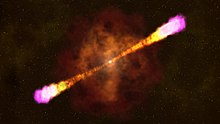GRB 160625B
 Typical Gamma-Ray Burst (illustration) | |
| Event type | Gamma-ray burst |
|---|---|
| Right ascension | 20h 34m 23.25s[1] |
| Declination | +06° 55 ′ 10.5″[1] |
| Other designations | GRB 160625B |
GRB 160625B was a bright gamma-ray burst (GRB) detected by NASA's Fermi Gamma-ray Space Telescope on 25 June 2016 and, three minutes later, by the Large Area Telescope.[1][2][3] This was followed by a bright prompt optical flash, during which variable linear polarization was measured[4] This is the first time that these observations are made when the GRB is still bright and active.[5] The source of the GRB was a possible black hole, within the Delphinus constellation,[6] about 9 billion light-years (light travel distance) away (a redshift of z = 1.406).[7]
See also[]
- List of gamma ray bursts
- Swift Gamma-Ray Burst Mission
- Ultra-Fast Flash Observatory Pathfinder
References[]
- ^ a b c Dirirsa, F.; et al. (26 June 2016). "GCN Circular: GRB 160625B: Fermi-LAT detection of a bright burst (and related)". NASA. Retrieved 27 July 2017.
- ^ Howell, Elizabeth (26 July 2017). "Boom! Powerful Cosmic Explosion May Hint at How Black Holes Form". Space.com. Retrieved 27 July 2017.
- ^ Staff (27 July 2017). "Gamma-ray burst captured in unprecedented detail". Astronomy Now. Retrieved 27 July 2017.
- ^ Troja, E.; et al. (27 July 2017). "Significant and variable linear polarization during the prompt optical flash of GRB 160625B" (PDF). Nature. 547 (7664): 425–427. Bibcode:2017Natur.547..425T. doi:10.1038/nature23289. PMID 28748924.
- ^ Mandelbaum, Ryan F. (27 July 2017). "Astronomers Capture Wild Intergalactic Gamma Ray Burst As it Happens". Gizmodo. Retrieved 27 July 2017.
- ^ Staff. "Finding the constellation which contains given sky coordinates". djm.cc. Retrieved 28 July 2017.
- ^ Greiner, Jochen (12 July 2017). "Gamma-ray Burst 160625B". Max Planck Institute for Extraterrestrial Physics. Retrieved 28 July 2017.
External links[]
Categories:
- Long-duration gamma-ray bursts
- Astronomical objects discovered in 2016
- June 2016 events


